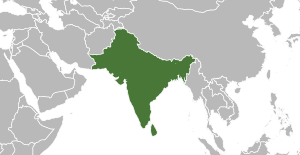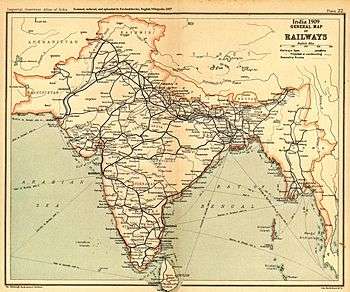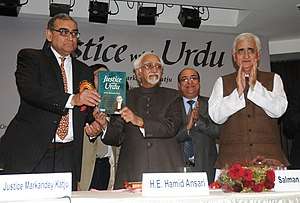Indian reunification
Indian reunification refers to the potential unification of India (the Republic of India) with what is now Bangladesh and Pakistan, the latter of which was partitioned from British India in 1947.

Background

In 1947, British India was partitioned into the modern Dominion of India and the Dominion of Pakistan, the latter of which included northwest India and part of eastern India.[1] Those who opposed the vivisection of the country often adhered to the doctrine of composite nationalism.[2] The Indian National Congress, as well as the All India Azad Muslim Conference, opposed the partition of India; the president of the All India Azad Muslim Conference and Chief Minister of Sind, Shadeed Allah Bakhsh Soomro, stated that “No power on earth can rob anyone of his faith and convictions, and no power on earth shall be permitted to rob Indian Muslims of their just rights as Indian nationals.”[3] Khaksar Movement leader Allama Mashriqi opposed the partition of India because he felt that if Muslims and Hindus had largely lived peacefully together in India for centuries, they could also do so in a free and united India (cf. Hindu-Muslim unity).[4] Mashriqi saw the two-nation theory as a plot of the British to maintain control of the region more easily, if India was divided into two countries that were pitted against one another.[4] He reasoned that a division of India along religious lines would breed fundamentalism and extremism on both sides of the border.[4] Mashriqi thought that "Muslim majority areas were already under Muslim rule, so if any Muslims wanted to move to these areas, they were free to do so without having to divide the country."[4] To him, separatist leaders "were power hungry and misleading Muslims in order to bolster their own power by serving the British agenda."[4]
The author of Composite Nationalism and Islam, Maulana Husain Ahmad Madani, a Deobandi Muslim scholar and proponent of a united India, argued that in order to maintain their divide and rule policy, the British were attempting to "scare Muslims into imagining that in a free India, Muslims would lose their separate identity and be absorbed into the Hindu fold", a threat that "aim[ed] at depoliticizing the Muslims, weaning them away from struggle for independence."[5] In the eyes of Madani, support for a two-nation theory resulted in the entrenchment of British imperialism.[5]
The pro-separatist All-India Muslim League, on the other hand, campaigned for a separate country, Pakistan, and their demand for the partition of India took place.[6] Since that time, various individuals and political parties, as well as religious groups have called for Indian reunification.[7]
Mahatma Gandhi, for example, had wished to settle in Noakhali in order to start a campaign for Indian reunification among the Muslim community of Pakistan.[8]
Indian nationalists felt that following the departure of the British from the Indian subcontinent, Pakisan would destabilize and reunite with India; both the British, as well as the Indian National Congress thus thought it would be best for the British to leave sooner.[8] On the other hand, Muhammad Ali Jinnah of the Muslim League wished to delay the departure of the British as he felt that it would allow the newly created state of Pakistan to receive its share of join assets.[8]
In August 1953, several newspapers in India reported that meetings held on United India Day presented Indian reunification as the goal of patriots.[8] One of them, Parbhat wrote that: "Pakistani leaders are well aware of the fact that the majority of the Indian population does not accept the partition of 1947 and will come out in the open to do away with it at the first opportunity."[8]
In the 1950s, the Sri Aurobindo Sevak Sangha included in their programme "Annulment of the ill-fated partition and reunification of India."[9] On 4 February 4 1957, the Muslim League's Morning News published an article stating that "there is a party even in Pakistan which is working for reunification and it is growing in strength", with reference to the Awami League, possibly in an attempt to lambast it.[9]
Lord Listowel remarked that "It is greatly to be hoped that when the disadvantages of separation have become apparent in the light of experience, the two Dominions will freely decide to reunite in a single Indian Dominion, which might achieve that position among the nations of the world to which its territories and resources would entitle it."[8]
The subject of undoing the partition and reunifying India has been discussed by both Indians and Pakistanis, especially in recent times.[10]
Views
Political thinkers

In The Nation, Kashmiri Indian thinker Markandey Katju has advocated the reunification of India with Pakistan under a secular government.[12] He stated that the cause of the partition was the divide and rule policy of Britain, which was implemented to spread communal hatred after Britain saw that Hindus and Muslims worked together to agitate against their colonial rule in India.[12] Katju serves as the chairman of the Indian Reunification Association (IRA), which seeks to campaign for this cause.[11][13]
Pakistani historian Nasim Yousaf, the grandson of Allama Mashriqi, has also championed Indian Reunification and presented the idea at the New York Conference on Asian Studies on 9 October 2009 at Cornell University; Yousaf stated that the partition of India itself was a result of the British interests and their divide and rule policy that sought to create another buffer state between the Soviet Union and India to prevent the spread of Communism, as well the fact that a "division of the people and territory would prevent a united India from emerging as a world power and keep the two nations dependent on pivotal powers."[14] Yousaf cited former Indian National Congress president Maulana Abul Kalam Azad, who wrote in the same vein:[14]
If a united India had become free...there was little chance that Britain could retain her position in the economic and industrial life of India. The partition of India, in which the Muslim majority provinces formed a separate and independent state, would, on the other hand, give Britain a foothold in India. A state dominated by the Muslim League would offer a permanent sphere of influence to the British. This was also bound to influence the attitude of India. With a British base in Pakistan, India would have to pay far greater attention to British interests than she might otherwise do. ... The partition of India would materially alter the situation in favour of the British.[14]
Yousaf holds that "Muhammad Ali Jinnah, the President of the All-India Muslim League and later founder of Pakistan, had been misleading the Muslim community in order to go down in history as the saviour of the Muslim cause and to become founder and first Governor General of Pakistan."[14] Allama Mashriqi, a nationalist Muslim, thus saw Jinnah as "becoming a tool in British hands for his political career."[14] Besides the pro-separatist Muslim League, Islamic leadership in British India rejected the notion of partitioning the country, exemplified by the fact that most Muslims in the heartland of the subcontinent remained where they were, rather than migrating to newly created state of Pakistan.[14] India and Pakistan are currently allocating a significant amount of their budget into military spending—money that could be spent in economic and social development.[14] Poverty, homelessness, illiteracy, terrorism and a lack of medical facilities, in Yousaf's eyes, would not be plaguing an undivided India as it would be more advantaged "economically, politically, and socially."[14] Yousaf has stated that Indians and Pakistanis speak a common lingua franca, Hindustani, "wear the same dress, eat the same food, enjoy the same music and movies, and communicate in the same style and on a similar wavelength".[14] He argues that uniting would be a challenge, though not impossible, citing the fall of the Berlin Wall and the consequent German Reunification as an example.[14]
French journalist François Gautier wrote that:[15]
Kashmir may hold the key to India's reunification with Pakistan, whether by force or by mutual consent. For that is the crux of the problem: as long as Pakistan and India are divided there will be other Kashmirs, other Ayodhyas, other wars with Pakistan--nuclear maybe--and India will never be at peace with its own Muslim community, which is a permanent danger to herself. For India and Pakistan Are one. Yet they are two different entities, each one with its own personality. Remember Sri Aurobindo's words in 1947, "The old communal division into Hindu and Muslim seems to have hardened into the figure of a permanent division of the country. It is hoped that the Congress and the nation will not accept the settled fact as for ever settled, or as anything more than a temporary expedient. For if it lasts, India may be seriously weakened, even crippled: civil strife may remain always possible; possible even a new invasion and foreign conquest. The Partition of the Country Must Go."[15]
Lal Khan, a Pakistani political activist and founder of the Marxist organization The Struggle, suggested that undoing the partition is a necessity because it would resolve the Kashmir conflict, as well as reduce the power of the "security-bureaucratic machine", thus guaranteeing a true secular, socialist and democratic society.[16] Advocating for a common revolution, Khan declared that "Five thousand years of common history, culture and society is too strong to be cleavaged by this partition."[17] His views are described his book "Crisis in the Indian Subcontinent, Partition: Can it be Undone?" in which Khan states that "revolutionary transformation of the economies and societies is an essential prerequisite for the reunification of the subcontinent."[18]
Reunification cannot be imposed on any nationality, community, religion or ethnic group. It must be a voluntary socialist federation. The main dynamic will be the programme and perspective of the revolutionary party, leading the insurrection. The programme must be based on the principles of scientific socialism. The eradication of misery, poverty, disease, ignorance, exploitation, national oppression and the subjugation of women and minorities in society is only possible through the overthrow of capitalism. The annihilation of the existing decaying and repressive states will be linked to the creation of a greater proletarian state based on a workers’ democracy. —Lal Khan[18]
Educationalist P. A. Inamdar commented at the Rangoonwala College of Dental Science in July 2017 that the reunification of Pakistan and Bangladesh with India would "keep India prosperous and peaceful".[19]
Religious groups
Kingsley Martin observed that "Hindus ... have not forgiven the Muslim League for destroying the unity of the subcontinent when the British agreed to independence."[8] Many Hindus were devastated by the fact that "part of the motherland envisaged in the ancient Hindu scriptures" was partitioned from India.[8] The Bharatiya Jana Sangh, a Hindu political organisation held the creation of Akhand Bharat as one of its objectives; in this context, Akhand Bharat's borders were that of India, before its partition in 1947.[20][21] Ram Madhav, a spokesman for the Rashtriya Swayamsevak Sangh, a Hindu nationalist organisation, stated that “The RSS still believes that one day these parts, which have for historical reasons separated only 60 years ago, will again, through popular goodwill, come together and Akhand Bharat will be created.”[19]
A group of 200 Islamic clerics gathered in Pune in July 2017 and issued a statement calling for Indian Reunification:[19]
Until and unless the borders of India are peaceful we won’t be able to achieve economical, societal and educational development. Tensions at borders are leading to enormous expenditures and development work is stalled. The division made by British was unnatural so we request honorable Prime Minister Narendra Modi to use all military options and unite Pakistan, Bangladesh and Afghanistan to make Akhand Bharat. The dream saw by Indian leaders before and after independence will come true and India will become most powerful country in the world.[19]
The musician Mehdi Hassan, when visiting Ajmer Sharif Dargah, always prayed for the "reunification of India and Pakistan in some peaceful form or the other."[22]
The Islamist group Lashkar-e-Taiba has framed the prophecy of Ghazwa-e-Hind, as one in which India is defeated and united with Pakistan, unifying the Indian subcontinent under Muslim rule.[23]
See also
- German reunification
- Korean reunification
- Romanian reunification
References
- Kolb, Tine (31 May 2016). "The tragedy of India's partition – Was the bloody path to independence really necessary?". Medium. Retrieved 9 February 2019.
- Na, Abdullahi Ahmed An-Na'im; Naʻīm, ʻAbd Allāh Aḥmad (2009). Islam and the Secular State. Harvard University Press. p. 156. ISBN 978-0-674-03376-4.
The Jamiya-i-ulama-Hind founded in 1919, strongly opposed partition in the 1940s and was committed to composite nationalism.
- Ali, Afsar (17 July 2017). "Partition of India and Patriotism of Indian Muslims". The Milli Gazette.
- Yousaf, Nasim (31 August 2018). "Why Allama Mashriqi opposed the partition of India?". Global Village Space. Retrieved 24 January 2019.
- Syeda, Lubna Shireen (2014), "Madani and Composite Nationalism", A study of Jamiat-Ulama-i-Hind with special reference to Maulana Hussain Ahmad Madani in freedom movement (A.D. 1919-A.D.1947), Dr. Babasaheb Ambedkar Marathwada University/Shodhganga, p. 207–211, 257–258
- Keen, Shirin (1998). "Partition of India". Emory University. Retrieved 9 February 2019.
- Alastair Lamb (1971). "Review: War in the Himalayas". Modern Asian Studies. Cambridge University Press. 5 (4): 397. JSTOR 312054.
- Burke, S. M. (1974). Mainsprings of Indian and Pakistani Foreign Policies. University of Minnesota Press. pp. 57–59, 66–67, 73. ISBN 9781452910710.
- Lambert, Richard D. (1959). "Factors in Bengali Regionalism in Pakistan". Far Eastern Survey. American Institute of Pacific Relations. 28 (4): 56.
That such plots continue to be discovered is indicated in an editorial in the Morning News of February 4, 1957: A vigorous campaign has been launched in Bharat to undo Pakistan and re-unite it with Bharat, according to authoritative reports reaching here from Calcutta. A political party, the Sri Aurobindo Sevak Sangha which claims that its political programme is based on the 'teaching of Sri Aurobindo' is fighting general elections in Bharat with a programme the first item of which reads: 'Annulment of the ill-fated partition and reunification of India.' In its election manifesto, which has been widely distributed and even sent to some newspapers in Pakistan, the party claims that 'there is a party even in Pakistan which is working for reunification and it is growing in strength.' The editorial in this Muslim League newspaper goes on to remark that the party in East Bengal is not named but hints very strongly that it is the Awami League. It is this latter charge (that they are at best dupes and at worst agents of seditious groups) that has been used most effectively against the regionalist groups—so much so that it made Mr. Bhashani cry out in an interview, "Call me an agitator, call me anything, but when they say that I am an enemy of Pakistan and am destroying it, I can only cry my agony to the high heavens for justice and retribution."
- O'Mahony, Anthony; Siddiqui, Ataullah (2001). Christians and Muslims in the Commonwealth: A Dynamic Role in the Future. The Altajir Trust. ISBN 978-1-901435-08-5.
In South Asia, recent years have seen the subject of reunification being considered by people in both India and Pakistan. Inevitably, there is a diversity of views on such a subject. Among Indians and Pakistanis who generally agree on the merits of reunification, some regard it as feasible only when national prejudices of one country against the other are overcome.
- "Mission Statement of the Indian Reunification Association". Indica News. 7 February 2019.
- Markandey Katju. "The truth about Pakistan". The Nation. Archived from the original on 10 November 2013. Retrieved 29 January 2019.
- Markandey Katju (10 April 2017). "India And Pakistan Must Reunite For Their Mutual Good". The Huffington Post.
- Yousaf, Nasim (9 October 2009). "Pakistan and India: The Case for Unification". New York Conference on Asian Studies (NYSCAS).
- François Gautier (2001). A Western Journalist on India: The Ferengi's Columns. Har-Anand Publications. p. 29. ISBN 9788124107959.
- Samaddar, Ranabir (27 February 2008). "Indian review of 'Partition - can it be undone?'". Marxists Internet Archive.
- Khan, Lal; Ghosh, Paramita (24 October 2007). "Can Partition be Undone? – An Interview with Lal Khan". Radical Notes. Retrieved 29 June 2020.
- Khan, Lal (2005). Crisis in the Indian Subcontinent, Partition: Can it be Undone?. The Struggle Publications. pp. 127, 128.
- "Pune Muslim Clerics Support RSS' Akhand Bharat". 21 July 2017.
- Cush, Denise; Robinson, Catherine; York, Michael (2012). Encyclopedia of Hinduism. Routledge. p. 385. ISBN 9781135189785.
The reunification of India - Akhandha Bharat - was an objective and it rejected the notion of India as a federation of states, as stated in the Indian constitution, but considered it as Bhārat Māta (Mother India), the original pre-partition India, undivided and unitary.
- Indurthy, Rathnam (2019). India–Pakistan Wars and the Kashmir Crisis. Taylor & Francis. ISBN 9780429581762.
As such, the Jan Sangh Party (it later changed its name to the BJP) did not believe in the two-nation principle and, therefore, advocated for quite some time for the reunification of mother India with Pakistan.
- Kulkarni, Sudheendra (15 June 2012). "A poet-PMs get-well-soon letter to Mehdi Hassan". The Indian Express.
- Haqqani, Husain (27 March 2015). "Prophecy & the Jihad in the Indian Subcontinent - by Husain Haqqani". Hudson Institute.
For example, Lashkar-e-Taiba has often spoken of Ghazwa-e-Hind as a means of liberating Kashmir from Indian control. The group’s founder, Hafiz Muhammad Saeed, has declared repeatedly that “[i]f freedom is not given to the Kashmiris, then we will occupy the whole of India including Kashmir. We will launch Ghazwa-e-Hind. Our homework is complete to get Kashmir.” Pakistani propagandist Zaid Hamid has also repeatedly invoked Ghazwa-e-Hind as a battle against Hindu India led from Muslim Pakistan. According to Hamid, “Allah has destined the people of Pakistan” with victory and “Allah is the aid and helper of Pakistan.”